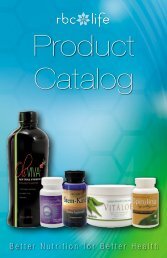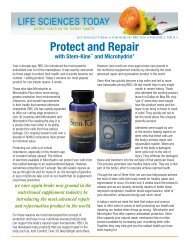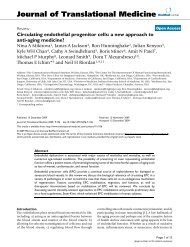Supplement Facts - RBC Life
Supplement Facts - RBC Life
Supplement Facts - RBC Life
You also want an ePaper? Increase the reach of your titles
YUMPU automatically turns print PDFs into web optimized ePapers that Google loves.
men and women in the United States do not consume adequate levels of vitamin C and about 10% of<br />
adults consume less than half the recommended amount. 210<br />
Vitamin C plays many critical roles in the body. It is a cofactor for several enzymes involved in the<br />
biosynthesis of collagen, carnitine, and several neurotransmitters. 211<br />
Vitamin C supports the immune system as well as heart and eye health. It also supports collagen<br />
structure in bone and connective tissue, including the gums. Vitamin C plays a role in the conversion<br />
of dopamine to norepinephrine, which supports a positive and happy mood. Lack of vitamin C can<br />
often cause fatigue and mood changes. 212<br />
Vitamin C functions as an antioxidant that readily scavenges reactive oxygen and nitrogen species,<br />
such as superoxide and peroxyl radicals, singlet oxygen, ozone, nitrogen dioxide and other free<br />
radicals. In addition to its direct role as an antioxidant, vitamin C can help regenerate vitamin E,<br />
glutathione, beta-carotene, and other antioxidants in the cell membrane and within the cell. 212<br />
Some scientific evidence suggests that consumption of antioxidant vitamins may reduce the risk<br />
of certain forms of cancer. However, the FDA does not endorse this claim because this evidence<br />
is limited and not conclusive.<br />
Vitamin D<br />
The major biologic function of vitamin D is to maintain normal blood levels of calcium and<br />
phosphorous. As part of this role, vitamin D aids in the absorption of calcium, which helps form and<br />
maintain strong bones. 213 Without vitamin D, the bones can become thin, soft, and brittle. 214 Rickets in<br />
214, 215<br />
children and osteomalacia in adults are skeletal diseases that are a result of vitamin D deficiency.<br />
Vitamin D deficiency occurs most often in post-menopausal women and older Americans. Research<br />
shows that a deficiency is associated with a greater incidence of hip fractures. 216 An increased vitamin<br />
D intake from diet and supplements has been associated with reduced bone loss in older women. 216<br />
Vitamin D may also help reduce the risk of osteoporotic fractures in elderly populations with low<br />
blood levels of vitamin D. 217<br />
To protect bone strength and support the absorption of calcium, <strong>RBC</strong> scientists have included 100%<br />
of the Daily Value for vitamin D in 24Seven <strong>Life</strong> Essentials.<br />
Vitamin E<br />
Vitamin E is a fat-soluble vitamin that exists in eight different forms. Each form has its own biological<br />
activity, which is the measure of potency or functional use in the body. 218 Alpha-tocopherol is the most<br />
active form of vitamin E in humans, and it acts as a powerful biological antioxidant. 219,220 Some<br />
scientific evidence suggests that consumption of antioxidant vitamins may reduce the risk of certain<br />
forms of cancer. However, the FDA does not endorse this claim because this evidence is limited and<br />
not conclusive. Studies have shown that vitamin E supports heart health and the health of the eyes. 221<br />
W H Y S U P P L E M E N T A T I O N I S V I T A L T O Y O U R G O O D H E A L T H 21







